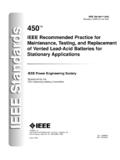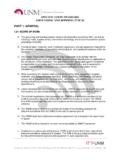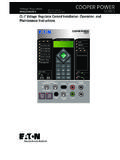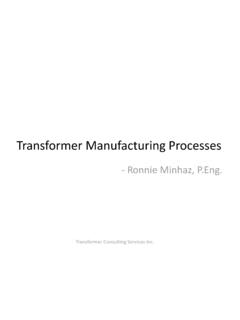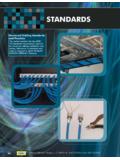Transcription of Leakage Current Measurement Reference Design for ...
1 TI Designs Leakage Current Measurement Reference Design for Determining Insulation Resistance Design Overview Design Features This TI Design provides a Reference solution to Leakage Current Measurement Circuit With Option measure the insulation resistance up to 100 M . The for Programmable Current Sense Amplifier and Design has an onboard, isolated 500-V DC power Switchable Shunt Resistors supply and an isolated signal conditioning circuit to Range of Measurement : 0 to 100 M . measure the Leakage Current and then determine the insulation resistance. Measurement Accuracy: 5% (Uncalibrated). Test Voltage Level Derived from IEEE 43-2000. Design Resources Onboard Isolated 500-V Power Supply to Measure Insulation Resistance TIDA-00440 Tool Folder Containing Design Files Provision for Calibration Resistor on Board INA225 Product Folder AMC1200 Product Folder Provision for Polarization Index Measurement CSD13202Q2 Product Folder Based on Test Duration ISO7640FM Product Folder Basic Isolation for Measurement Circuit INA333 Product Folder Onboard Relay to Disconnect the Insulation TS5A23157 Product Folder Measurement Circuit When Not in Operation LM5160 Product Folder TLV1117-50 Product Folder Featured Applications LP2985A-50 Product Folder Industrial Drives UCC28711 Product Folder Variable Speed AC/DC Drives Servo Drives ASK Our E2E
2 Experts Transformers WEBENCH Calculator Tools Solar Inverters Daughter Board Main Board 10-V to 20-V DC. 5V_VCC1 LDO. Low-voltage DC/DC (Fly-BuckTM) LM5160. 5V_VCC2 LDO. R LIMIT. V SENSE. AMC1200. CSM MUX. INA225 TS5A23157. V SENSE To MCU. 150-V Flyback to (DC/DC) 500-V DC. Digital ISO. 800-V UCC28711. Isolator 7640. DC. R CAL R ISO. R ISO = Insulation resistance R CAL = Calibration resistance Basic isolation An IMPORTANT NOTICE at the end of this TI Reference Design addresses authorized use, intellectual property matters and other important disclaimers and information. TIDU873A April 2015 Revised April 2015 Leakage Current Measurement Reference Design for Determining Insulation 1. Submit Documentation Feedback Resistance Copyright 2015, Texas Instruments Incorporated Introduction 1 Introduction The deterioration of insulation is one of the primary causes of electrical equipment failure.
3 This TI Design provides a Reference solution to measure the insulation resistance up to 100 M with an uncalibrated accuracy of 5%. The Reference Design uses an onboard isolated 500-V DC power supply and isolated signal conditioning circuit to measure the Leakage Current for determining the insulation resistance. Importance of Insulation Measurement Insulating materials play a critical role in the life of electrical equipment. The failure of insulation, while in service, may cause significant damage to equipment and to the system to which the equipment is connected. Insulation failure can cause dangerous voltage, fire, high fault Current and explosion, damage to equipment and property, personnel injury, and fatal accident.
4 By applying insulation tests, the user can identify deteriorated insulation before any failure occurs. Causes of Insulation Degradation The main causes of insulation failure are dielectric contamination, temperature cycling, excessive overloads, excessive voltage stress due to overvoltage, and aging. 1. Thermal stress: Running the machine in excessively hot or cold conditions causes over expansion or contraction of the insulation, which may result in cracks and failures. However, thermal stresses are also incurred every time a machine starts or stops. Unless the machinery is designed for intermittent use, every stop and start adversely affects the aging process of the insulation. 2. Electric stress: Insulation is designed for a particular application.
5 Overvoltages cause abnormal stress within the insulation, which can lead to cracking or delamination of the insulation. 3. Voltage unbalance: When the voltage between all three phases is equal (balanced), the Current values are the same in each phase winding. When the voltages between the three phases (AB, BC, and CA). are not equal (unbalanced), the Current increases dramatically in the motor windings. If the user allows this increase to continue for too long, the motor is damaged. Normal cycles of operation lead to aging through the previously mentioned mechanisms. The aging of insulation is a slow process of degradation as these factors interact with each other in a gradual spiral of decline. At some point, depending on both original and operating conditions, the decline may speed up significantly.
6 2 Leakage Current Measurement Reference Design for Determining Insulation TIDU873A April 2015 Revised April 2015. Resistance Submit Documentation Feedback Copyright 2015, Texas Instruments Incorporated System Description 2 System Description The TIDA-00440 Reference Design uses a mechanism to find the Leakage Current and detect the failure in insulation. The Leakage Current is measured by applying a fixed, high voltage DC and by measuring the Leakage Current flowing through the shunt. The high voltage DC is generated using an onboard power supply based on a flyback topology, which takes a wide range of DC input voltage from 150-V DC to 800-V DC. The functionality of finding insulation resistance is implemented using two boards: the main board (TIDA-00440MB), which is the signal conditioning circuit , and the daughter board (TIDA-00440DB), which has an Isolated 500-V DC.
7 One important point to note is that the test levels, test voltage, and insulation levels derive from the IEEE. standard IEEE43-2000 (IEEE Recommended Practice for Testing Insulation Resistance of Rotating Machinery [1]). This standard describes a recommended procedure for measuring insulation resistance and describes the typical insulation resistance characteristics of rotating machine windings and how these characteristics indicate winding condition. This standard recommends the minimum acceptable values of insulation resistance for AC and DC rotating machine windings. Using this standard as a base, Table 1. makes the following judgments: Table 1. Insulation Resistance INSULATION. JUDGEMENT. RESISTANCE.
8 100 M or higher Acceptable. 10 to 100 M The winding has begun deteriorating. There is no problem with the performance at present. Be sure to perform a periodic inspection. 1 to 10 M The winding has considerably deteriorated. Special care is required. Be sure to perform a periodic inspection. Lower than 1 M Unacceptable. 3 Design Features The TIDA-00440 Reference Design features the following characteristics: 1. Leakage Current Measurement circuit with option for: (a) Programmable Current sense amplifier: INA225 has four gain-settings selected based on the GS0. and GS1. (b) Switchable shunt resistors 2. Facilitates online insulation Measurement during installation and maintenance testing 3. Range of Measurement : 0 to 100 M.
9 4. Measurement accuracy: 5% (Uncalibrated). 5. Test voltage Level derived from IEEE 43-2000 (Recommended Practice for Testing Insulation Resistance of Rotating Machinery). 6. Onboard isolated 500-V power supply to measure insulation resistance 7. Provision for calibration resistor on board 8. Provision for polarization index Measurement based on test duration 9. Basic isolation for Measurement circuit 10. Onboard relay to disconnect the insulation Measurement circuit when not in operation TIDU873A April 2015 Revised April 2015 Leakage Current Measurement Reference Design for Determining Insulation 3. Submit Documentation Feedback Resistance Copyright 2015, Texas Instruments Incorporated Block Diagram 4 Block Diagram Daughter Board Main Board 10-V to 20-V DC.
10 5V_VCC1 LDO. Low-voltage DC/DC (Fly-BuckTM) LM5160. 5V_VCC2 LDO. R LIMIT. V SENSE. AMC1200. CSM MUX. INA225 TS5A23157. V SENSE To MCU. 150-V Flyback to (DC/DC) 500-V DC. Digital ISO. 800-V UCC28711. Isolator 7640. DC. R CAL R ISO. R ISO = Insulation resistance R CAL = Calibration resistance Basic isolation Figure 1. High-Level Block Diagram of Measurement Circuit Figure 1 shows the high-level block diagram of the Measurement circuit. As previously mentioned, this Design consists of two boards: one main board (TIDA-00440MB) and one daughter board (TIDA-00440DB). The flyback (DC/DC) block on the left side of Figure 1 is the daughter board. All the remaining blocks are present on the main board. The Leakage Current is measured by applying a fixed voltage and measuring the voltage across the shunt that is a result of the Leakage Current .











